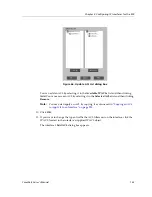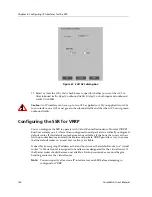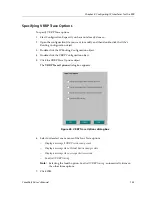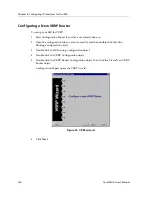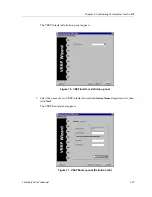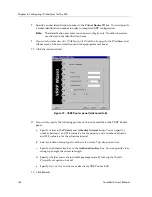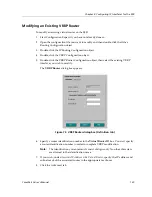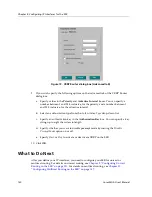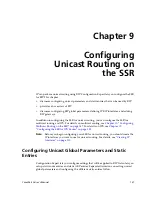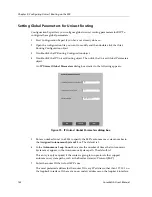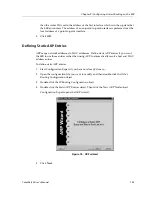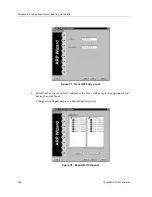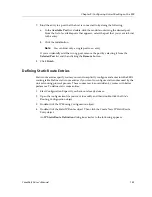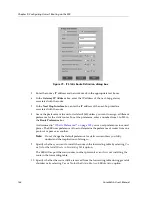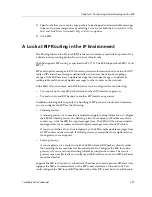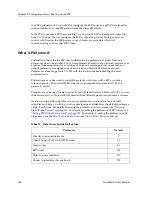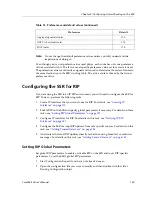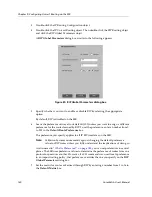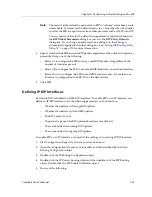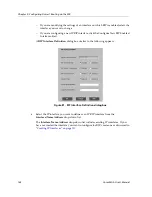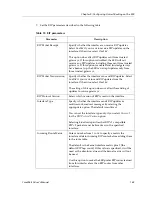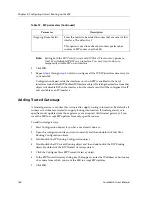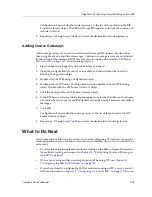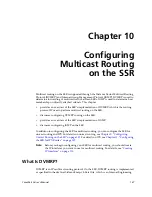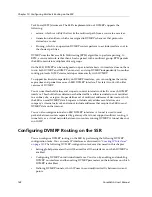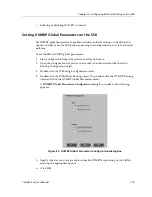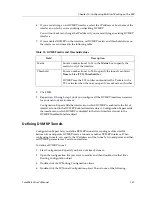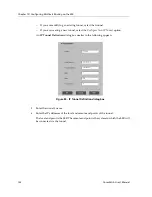
CoreWatch User’s Manual
137
Chapter 9: Configuring Unicast Routing on the SSR
11. Specify whether you want to cause packets to be dropped and unreachable messages
to be sent to packet originators by selecting
Yes
or
No
for both the
Reject packets to this
Host
and
Send Route Unreachable Msg on Rejection
options.
12. Click
OK
.
A Look at RIP Routing in the IP Environment
The Routing Information Protocol (RIP) is the most commonly used interior protocol. It is
a distance-vector routing protocol for use in small networks.
The SSR supports RIP routing as specified in RFC 1721. The SSR supports both RIP v1 and
RIP v2.
RIP sends update messages to RIP routers to provide information about a network’s RIP
routes. RIP sends these messages periodically or whenever the network's topology
changes. If the SSR receives an update message that includes changes, it updates its
routing table and then sends update messages to other routers on the network.
In the SSR's IP environment, each RIP interface can be configured for the following:
•
To accept or not accept RIP packets from another RIP interface or gateway.
•
To send or not send RIP packets to another RIP interface or gateway.
In addition to being able to specify the handling of RIP packets on individual interfaces,
you can configure the SSR for the following:
•
Trusted gateways
A trusted gateway is a router that is trusted to supply routing information. Configure
the SSR for trusted gateways by defining a list of host names or IP addresses of the
routers you want the SSR to accept messages from. The SSR will then accept update
messages from those routers and reject update messages from other RIP routers.
If you do not define a list of trusted gateways, the SSR accepts update messages from
all RIP routers on the network. If trusted gateways are specified, only updates from
those gateways are accepted.
•
Source gateways
A source gateway is a router to which the SSR will send RIP packets directly rather
than sending them as multicast or broadcast packets. Configure the SSR for source
gateways if you want to send routing information to specific routers. The source
gateways are not affected if you configure an SSR interface not to send RIP packets as
mentioned earlier.
Suppose the SSR is attached to a subnetwork that does not need to process RIP data. Also
suppose the SSR is to communicate with a RIP router elsewhere on the network. You
could configure the SSR to send RIP packets to the other RIP router but not send them to
Содержание CoreWatch
Страница 1: ...CoreWatch User s Manual 9032564 04...
Страница 2: ...Notice 2 CoreWatch User s Manual...
Страница 20: ...Preface 20 CoreWatch User s Manual...
Страница 64: ...Chapter 5 Changing System Settings 64 CoreWatch User s Manual...
Страница 86: ...Chapter 6 Configuring SSR Bridging 86 CoreWatch User s Manual...
Страница 106: ...Chapter 7 Configuring VLANs on the SSR 106 CoreWatch User s Manual...
Страница 206: ...Chapter 12 Configuring QoS on the SSR 206 CoreWatch User s Manual...
Страница 246: ...Chapter 13 Configuring Security on the SSR 246 CoreWatch User s Manual...
Страница 274: ...Chapter 15 Configuring BGP on the SSR 274 CoreWatch User s Manual Figure 184 BGP Peer Group Definition panel Options tab...
Страница 363: ...CoreWatch User s Manual 363 Chapter 16 Configuring Routing Policies on the SSR 9 Click OK...
Страница 364: ...Chapter 16 Configuring Routing Policies on the SSR 364 CoreWatch User s Manual...
Страница 370: ...Chapter 17 Checking System Status 370 CoreWatch User s Manual...
Страница 390: ...Chapter 18 Monitoring Real Time Performance 390 CoreWatch User s Manual...
Страница 396: ...Chapter 19 Checking the Status of Bridge Tables 396 CoreWatch User s Manual...
Страница 430: ...Chapter 20 Checking the Status of Routing Tables 430 CoreWatch User s Manual...
Страница 442: ...Chapter 22 Obtaining Reports 442 CoreWatch User s Manual...
Страница 456: ...Appendix B CoreWatch Menus 456 CoreWatch User s Manual...

